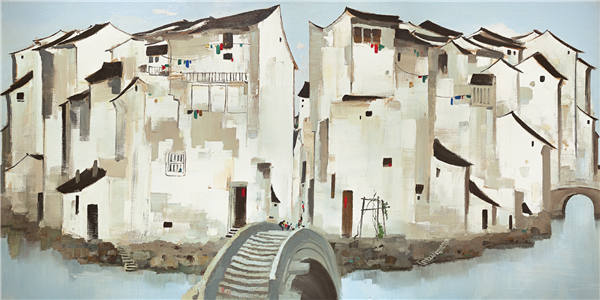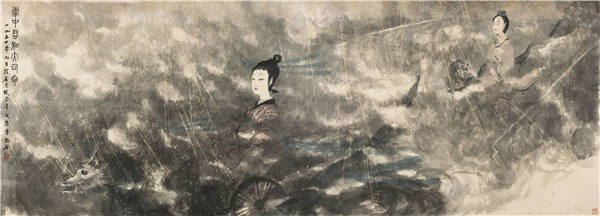
Wu Guanzhong's oil painting Zhouzhuang, based on a pencil sketch from 1985, was done after several visits to a peaceful water town in Jiangsu province.
Works by two leaders of modern Chinese painting will be on view in Hong Kong before going up for auction.
Two huge paintings, by Chinese modern masters Wu Guanzhong (1919-2010) and Fu Baoshi (1904-65) respectively, will be shown in Hong Kong from March 23 to April 6, before appearing at Poly Auction's major spring sales.
Wu's landscape on oil canvas, Zhouzhuang, represents his mastery in portraying picturesque Jiangnan or the southern area in the lower reaches of the Yangtze River.
He executed the work in 1997 using a simple palette-mainly black, white and gray-to bring out a sense of tranquility. He drew many blocks to outline Zhouzhuang's traditional folk houses that feature white walls and black roofs.
Wu received professional training at the national fine art school, now the China Academy of Art in Hangzhou, Zhejiang province, studying under great painters including Lin Fengmian and Pan Tianshou. He furthered studies at the National School of Fine Arts in Paris in 1946, exposed to a vibrant scene of modern art movements. He stayed there till his return to China in the 1950s.
Wu's academic background enabled him to build up a distinguished art vocabulary that bridges the essence of Chinese ink and wash and Western oil painting.
His artworks show the influence of Minimalism, Cubism and abstract expressionist artists such as Jackson Pollock, but retain the literati temperament of Chinese art traditions.
Wu first traveled to Zhouzhuang, an ancient water town in Jiangsu province, in the 1980s, and was amazed by its beauty, peace and solitude. He visited it several times afterwards, painting a dozen landscapes which can be rarely seen in today's Zhouzhuang, a highly commercial and tourist destination.
"A native of Jiangsu, Wu was familiar with water towns and knew how to present their beauty," says Li Dajun, deputy director of Wu Guanzhong Art Research Center, at Beijing's Tsinghua University.
"He produced the work in his late 70s when he was physically in a good condition and felt utmost confidence in creation. It is therefore a landmark piece in his oeuvre."
The work is an enlarged re-creation of a pencil sketch made in 1985. Almost 3 meters long, it was commissioned by Kwee Swie Teng, an Indonesian entrepreneur and an avid collector of Wu's art. He asked Wu to create the painting for a private Art Retreat Museum he was to build in Singapore.
The work will be auctioned at Poly's sale in Hong Kong in early April, estimated at HK$200 million ($25.7 million).
In his ink work God of Cloud and Great Lord of Fate, Fu depicts a mythical theme with sublime imagination.

He visualized two fairies mentioned in Jiu Ge (Nine Songs), a section of the poem collection Chuci (The Songs of Chu) believed written by Qu Yuan, the poet living during the Warring States Period (475-221 BC). He completed the huge painting more than six decades ago.
In Qu Yuan's original verses, the God of Cloud rules the order of wind, rain, thunder and light while the Great Lord of Fate controls a person's lifespan.
Fu drew the two unrelated figures together, giving the God of Cloud a feminine look. The character had been identified as a man in many scholars' interpretation while it was thought to be a woman by Guo Moruo, the author and historian acquainted with Fu. With his work, Fu injected a romantic feeling into the painting.
Furthermore he placed the gods in a background of a fierce lightning storm, which forms a contrast with their calm attitude.
Xiao Ping, a Beijing-based connoisseur of classic Chinese painting, says that Fu's brushwork has brought grace and vitality to the gods, which he inherited by studying masterpieces of ancient Chinese painters such as Gu Kaizhi.
"But taking a close look, one will feel that the gods look like ordinary people around us and that the human society and the deity's world are close to each other. That is why Fu's paintings move people so much," he says.
Fu was so inspired by Jiu Ge that he created more than 10 works. Three themed on the God of Cloud and Great Lord of Fate are known to exist.
The painting, a highlight Poly's Beijing sale in June, is estimated to be worth 180 million yuan ($27.8 million).
IF YOU GO
March 23-April 4 Poly Gallery Hong Kong, 7/F, One Pacific Place, 88 Queensway, Admiralty, Hong Kong
852-2303-9876


















































